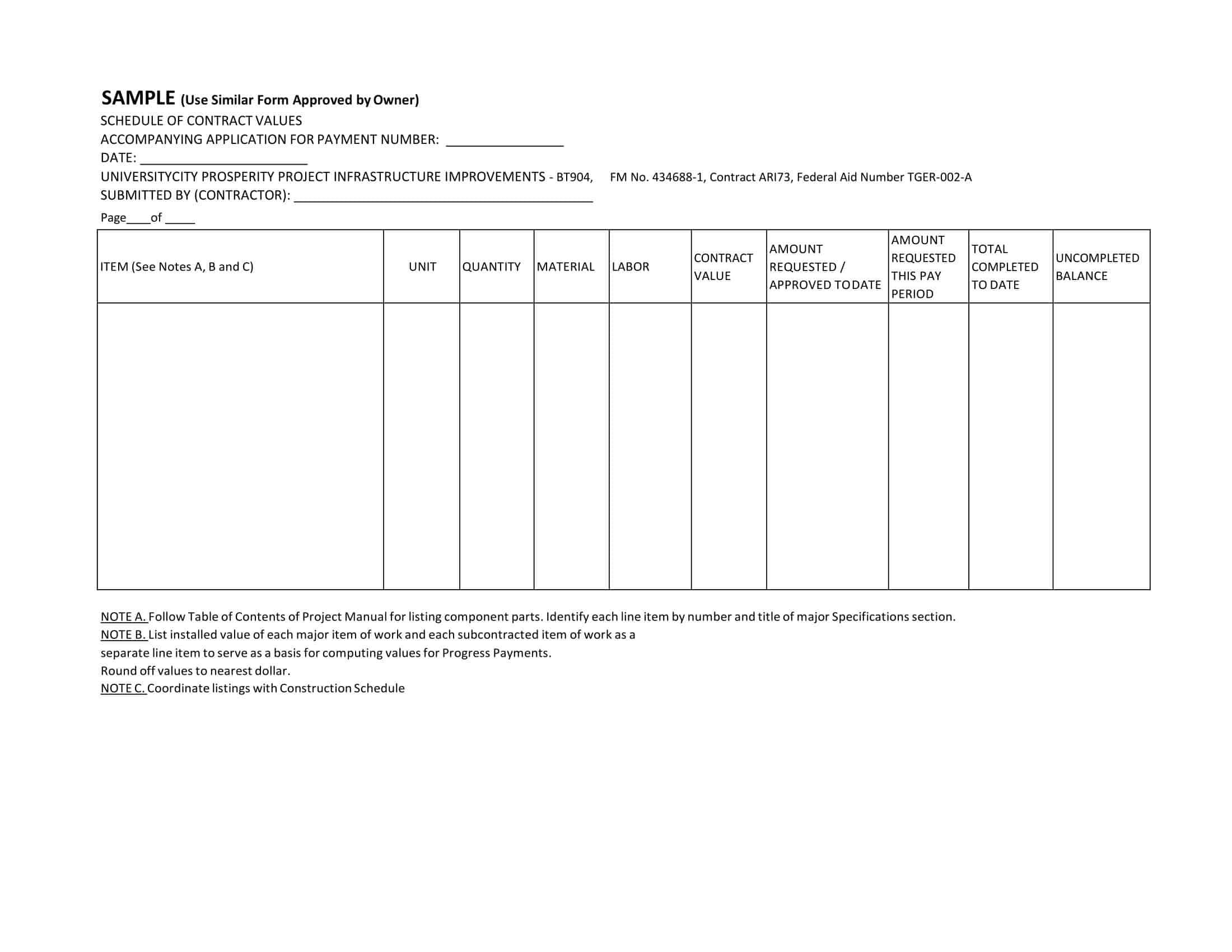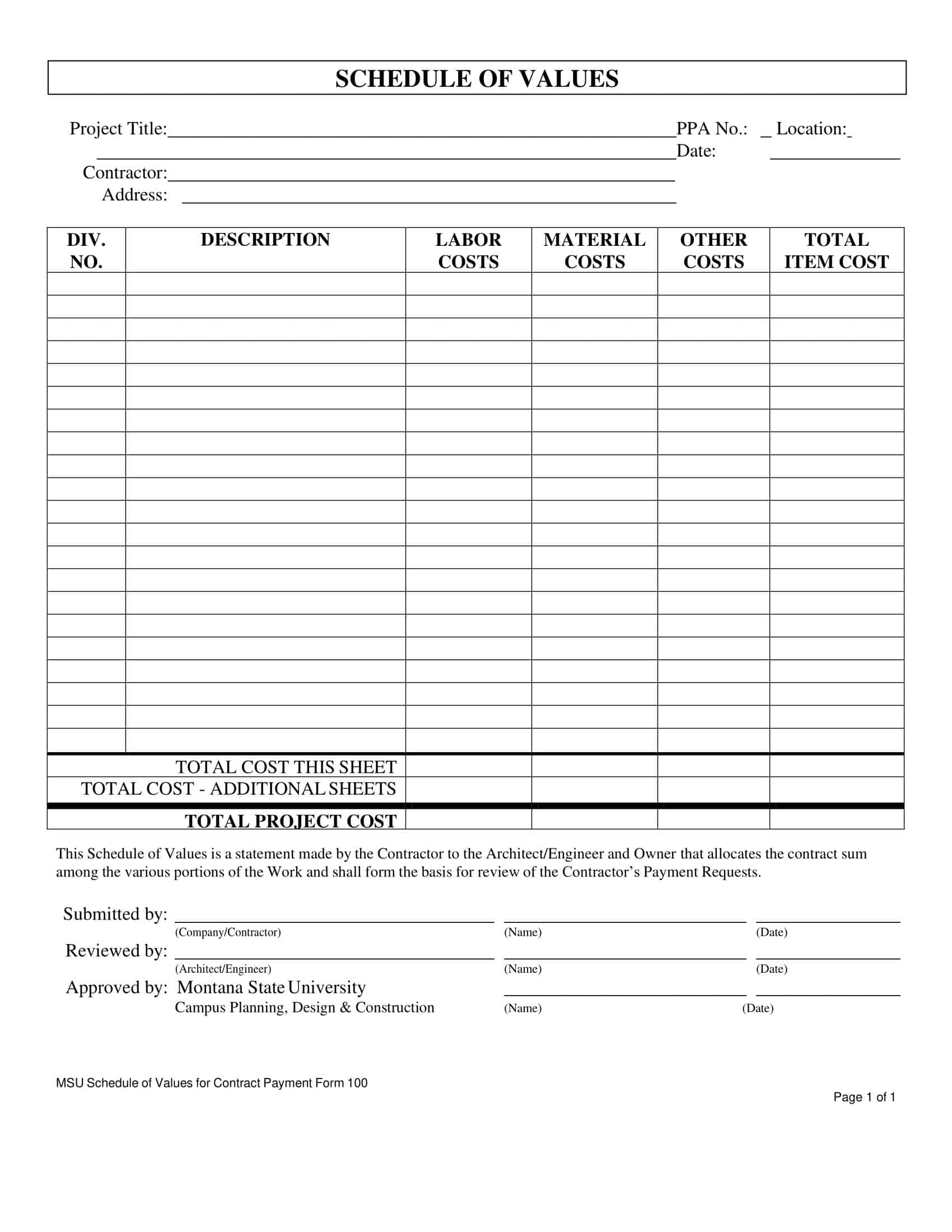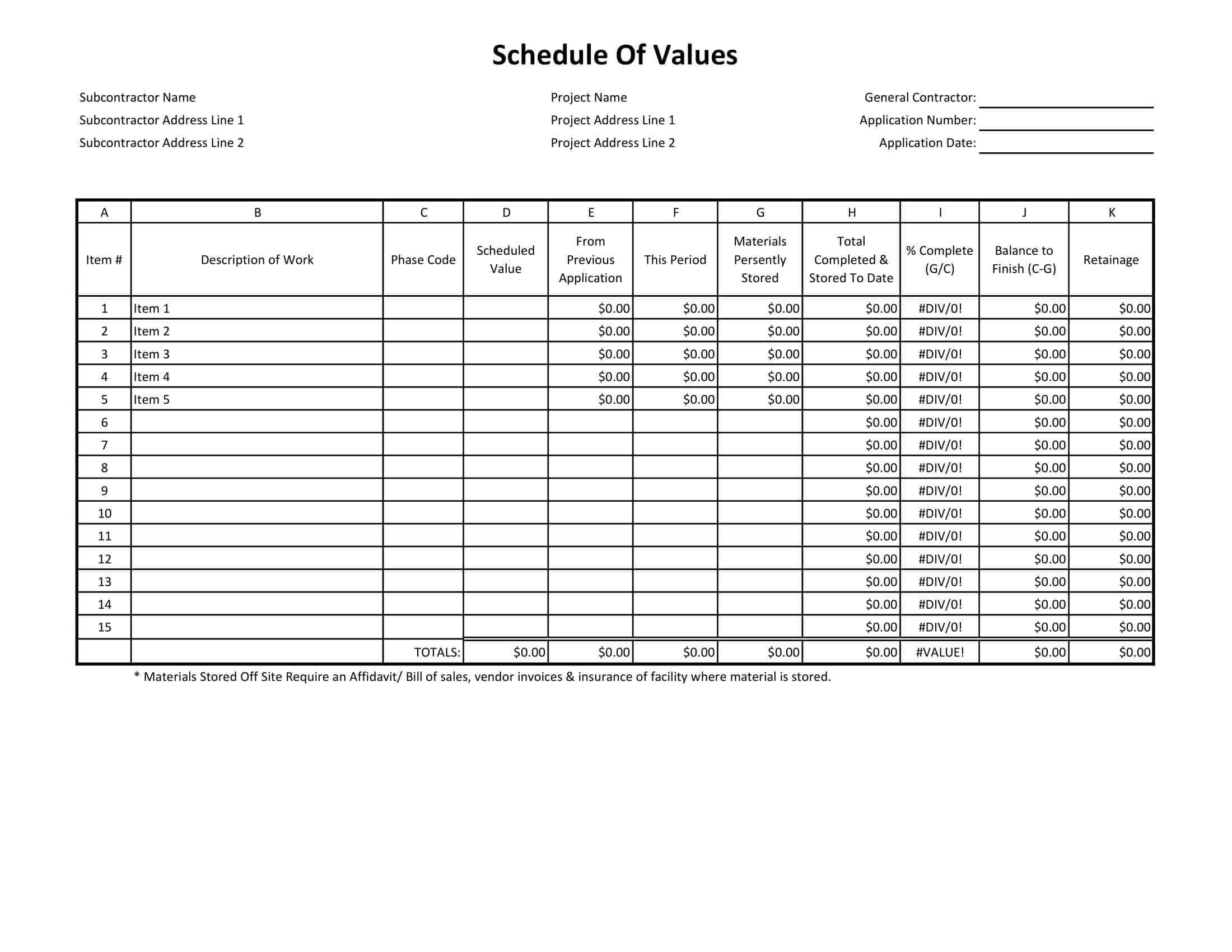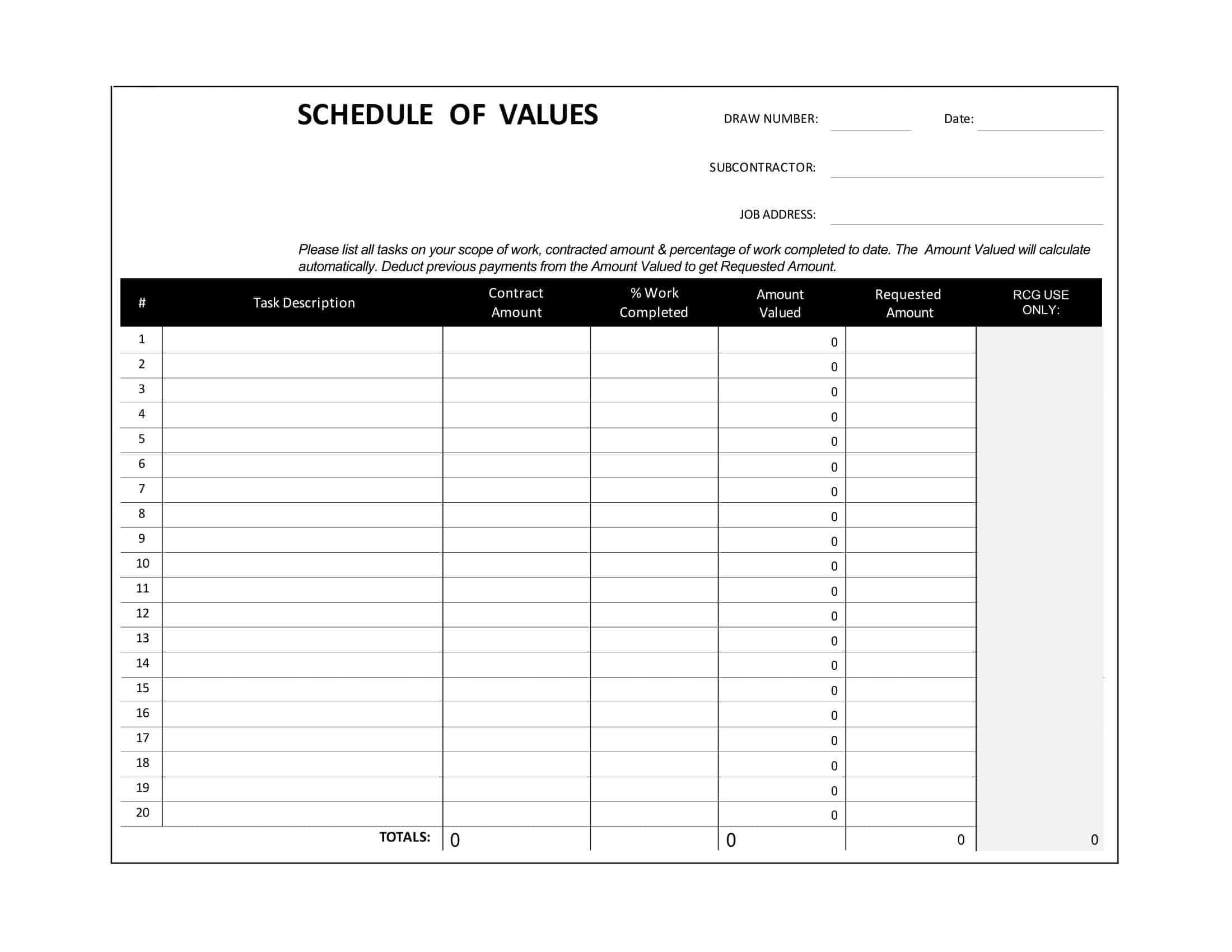A schedule of Values, often known as a construction contract template, is an essential document that is finalized during the time of entering a contract. This spreadsheet details the expenditures that are to be incurred to perform each phase of the project. The overall cost for the entire project is calculated after adding up the figures from each phase.
Table of Contents
Schedule of Values Templates
Effectively manage project budgets and payments with our comprehensive collection of Schedule of Values Templates. A Schedule of Values is a document used in construction projects to outline the budgeted cost of each item or work component. Our customizable and printable templates provide a structured format for creating and maintaining accurate Schedule of Values.
With sections for item descriptions, quantities, unit costs, and total values, our templates help you track and manage project expenses, monitor progress, and ensure timely and accurate payments. By utilizing our Schedule of Values Templates, you can enhance financial transparency, prevent cost overruns, and maintain a clear record of project costs and payments. Streamline your construction project management and financial tracking efforts with our user-friendly templates. Download now and stay on top of your project’s budget and financial health.
How is a Schedule of Values used on a construction project?

The Schedule of Values, often abbreviated SOV, is a tool used on a project to track costs in percentages, allowing the project owner or architect to efficiently know the percentage of the project that’s been completed while keeping tabs on how much will remain to be paid. The tool also serves small-business owners and operators by helping them manage effective cash flow, track progress as work is completed, send them invoices at regular times, and request payment for completed work.
Importance of Schedule of Values
Many construction companies in the world maintain a detailed schedule of values spreadsheet to make sure that the funds are being utilized correctly. The schedule of values form is prepared once the project starts and is reviewed during every phase of the project.
The detailed schedule of values spreadsheet specially created by experts in the industry helps in keeping a track of what amount has been spent on which material and when. It also includes details about subcontractors so that all information regarding the project can be obtained in one place. It also makes it easier for the project to obtain loans and hedge funds if available.
What should be included in a schedule of values?
A schedule of values (SOV) is a critical aspect of construction project documents. At best, an SOV details the materials, labor, and other services to be provided in compliance with the contract documents and identifies any permitted variations from the contract documents. At worst, it lacks information that is necessary to properly manage and perform the work outlined in it.
As a best practice, SOVs should include the following:
- Business Information
- A detailed description of each work item
- Cost for each work item
- The amount that has been paid to date
- Percentage of work completed
- Current costs
- The remaining cost for completion
- Retainage costs, percentages, and amounts for each item
- Consent and acknowledgment
How do you fill a schedule of values?
The schedule of values (SOV) spreadsheet is a vital component when working on your project. As the name suggests, it allows you to fill in information that can help you know its value. That’s why this sheet needs to be filled out correctly. But how do you do that? Let’s see this together:
The item’s number
When you are planning your schedule of values (SOV), you will get to a point where there will be no room for any more items. You could either delete an item and create another SOV or fill in the allocated numbers of each item. Using the second option will make referencing easy instead of searching through names or words which can sometimes be challenging.
Enter values
When creating your schedule of values, you must be sure that the items add up correctly to the total price. If there is any discrepancy or doubt on a certain item of work or cost regarding the project, it must be discussed with the estimator and itemized.
Enter details of work
Before the project commences, you will have an itemized schedule of values detailing work and costs. One of the things that are vital to your company’s profitability is ascertaining how much you will cost for your projects. As you can tell from the above explanation, it can depend on many factors and conditions.
Calculate and enter the percentage
Most of the works undertaken are of indeterminate value as they have many contingencies and interactions with other works. In this case, activity milestones or percentage of completed work is used to know the status of a project.
Calculate and enter the balance to finish
The information in this section is how to calculate the balance of payments. The first thing to do is put the amount of budget that is allocated for windows and panes in the schedule of values form. After you’ve done this now, we can add the amount already spent in the second column.
Calculate and enter the retainage percentage
Retainage is a percentage that the contractor keeps, to be paid back if you do not cause any loss or damage to the materials stored at the facility. To determine a fair retainage percentage value, you must take the value of stored materials or inventory you plan to store in advance, and times it by ten percent.
Conclusion
It may seem complicated, but the fact is that construction contracts are simple to create if you know the right way. Our suggestion is to consult an experienced construction attorney to draw up these contracts and make sure they meet the standard requirements of your state. It’s just a little effort to make sure your business interests are protected, and you can avoid costly lawsuits in the future.
FAQs
What is a Schedule of Values?
A Schedule of Values (SOV) is a detailed breakdown of the costs associated with a construction project, listing each component’s value. It’s commonly used in construction contracts as a billing tool.
Why is a Schedule of Values important?
The SOV provides clarity by itemizing the costs and progress for each construction activity. It aids in monitoring project progress, managing cash flow, and ensuring that payments align with work completed.
How is a Schedule of Values created?
Typically, contractors develop the SOV in collaboration with project stakeholders. It begins with dividing the project into distinct tasks or components and then assigning a value to each based on the contract amount.
Does the Schedule of Values include indirect costs?
Yes, SOVs often include indirect costs like overhead, insurance, and bond costs. These are typically prorated across the project’s duration.
How is work progress measured using the Schedule of Values?
Contractors submit periodic (often monthly) applications for payment, indicating the percentage of each task completed. By comparing these percentages with the SOV, stakeholders can gauge work progress and release payments accordingly.
Is the Schedule of Values the same as a project budget?
Not exactly. While both relate to project costs, the SOV is more detailed and specifically geared towards facilitating periodic billing. A project budget, on the other hand, is a broader financial plan for the entire project.
Can changes in the project scope affect the Schedule of Values?
Yes, significant changes or amendments to project scope will likely necessitate adjustments to the SOV to ensure accurate billing and project tracking.
How do change orders impact the Schedule of Values?
Change orders, which authorize modifications in the project’s original scope, can result in additions or deductions in the SOV. These changes should be itemized separately to maintain clarity.
What happens if there’s a discrepancy in the Schedule of Values?
Any discrepancies, whether in task valuation or progress reporting, should be discussed and resolved between the involved parties—usually the contractor and the project owner or their representatives.
Do all construction projects need a Schedule of Values?
While especially beneficial for large or complex projects, any project that uses a progress billing method can benefit from an SOV. It helps in maintaining transparency and organized billing.












































![Free Printable Food Diary Templates [Word, Excel, PDF] 1 Food Diary](https://www.typecalendar.com/wp-content/uploads/2023/05/Food-Diary-1-150x150.jpg 150w, https://www.typecalendar.com/wp-content/uploads/2023/05/Food-Diary-1-1200x1200.jpg 1200w)
![Free Printable Credit Card Authorization Form Templates [PDF, Word, Excel] 2 Credit Card Authorization Form](https://www.typecalendar.com/wp-content/uploads/2023/06/Credit-Card-Authorization-Form-150x150.jpg)
![Free Printable Stock Ledger Templates [Excel,PDF, Word] 3 Stock Ledger](https://www.typecalendar.com/wp-content/uploads/2023/08/Stock-Ledger-150x150.jpg)
